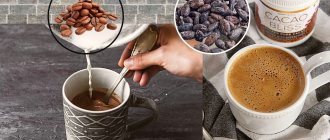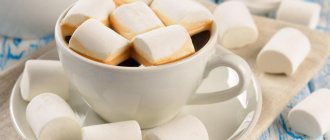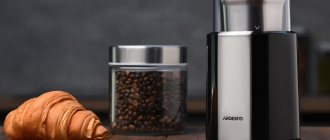Acidity is one of the most important parameters of coffee taste. Professionals distinguish several shades and find their charm in sourness, but many people at first find it unusual. So, let’s figure out why coffee is sour, what shades there are, how to choose more or less sour coffee or correct its taste according to your preferences.
What determines the sour taste of coffee?
As a rule, sourness is inherent only in Arabica. Elite varieties of Arabica grow at high altitudes, and in the absence of oxygen they ripen for a long time, so they get a rich taste. The higher the area where the grains grow, the more acidity will be felt. Arabica beans contain more than 30 different acids, but in general, baristas divide them into three types:
- Sourness from cocoa or nuts (found in beans from Nicaragua);
- Citrus acidity (berry, lemon, orange - typical, for example, of Costa Rica);
- Floral acid (also known as grape acid, slightly reminiscent of the taste of grapes, found in Yemen, Ethiopia Yirgachef, sometimes in Mexico).
The processing of the beans is also important: “washed” Arabica (you can find the “Washed” mark on the packaging) retains more acid in the taste than dry-processed (“Unwashed”).
The next stage of processing, which affects acidity, is roasting. The lighter it is, the more acids are stored inside the grain, and when grinding and cooking they are released into the drink. The darker the roast, the less sour the coffee will taste, but the stronger the hints of bitterness will appear.
In blends (a mixture of Arabica and Robusta), the degree of acidity is determined by the amount of Arabica added. If there is more of it, the coffee will have a certain acidity; if there is more of Robusta, the sourness will be only slightly detectable.
Robusta is never sour, except for the variety from Guatemala, but Arabica is added to this blend. 100% pure Robusta is always bitter.
Processing errors
Bitter coffees sometimes give off an unpleasant acidic aftertaste. The reasons are violations of processing technology.
For example, when grains are not completely dried during preparation. Or moisture got on them at one of the processing stages.
Also, sourness appears during long fermentation - fermentation. This processing stage is comparable in importance to roasting. The grains are kept in a large vat for about 30-60 hours to remove the pulp. If the beans are left in the container longer than expected, they begin to sour.
Coffee turns sour after processing in low-quality dirty water. If you use unpurified water and dirty vats during fermentation, the taste will deteriorate.
Also, sourness appears if some of the coffee berries remain in the vat. They are processed again, then find themselves among clean grains.
In this case, a small handful of grains will ruin the entire mixture. Even mild Robusta varieties will have an aftertaste.
Features of making coffee with or without sourness
The fresher the beans are roasted, the more acidic they will be in taste, to the detriment of other characteristics. It's best to wait a few days before making coffee from them.
You can bring out maximum acidity in your coffee by preparing espresso in a coffee machine. In the first couple of seconds of the strait, maximum acidity comes out, then sweet tones are revealed and at the end - bitterness.
If you want to correct overly sour coffee, do not replace the cup immediately, but after the drink has been spilled for a couple of seconds. This way you will “catch” only sweet and bitter shades into the cup. Keep in mind that this will also reduce the overall richness of taste and aroma, since it is the essential oils and acids that create the taste.
Coffee in a French press always turns out to be both more sour and more bitter, due to the large amount of water and long contact with it (more caffeine and acids come out).
Coffee prepared using the pour-over method (especially chario and cold brew) has minimal acidity.
Sometimes the acidity is more pronounced if you pour hot coffee into a cold mug. Run the cup under hot water to warm it and see if the taste of the drink changes.
Milk (cream) and sugar can also mask the acidity and correct the drink if it is too sour for you.
Ways to reduce acidity
The acidity of the coffee may be limiting for some. Here are some ways to reduce the acidity of coffee:
- Choose darker roasted coffee.
- Drink iced coffee instead of hot.
- Increase the cooking time, for example, using a French press.
- Choose a coarser grind.
- Brew coffee at a lower temperature.
Summary
Because coffee is acidic, it can affect certain health conditions such as acid reflux and irritable bowel syndrome. So, some people may need to avoid it. Although the acidity of this drink cannot be eliminated, there are several ways to reduce it.
With an average pH of 4.85 to 5.10, most coffee is considered quite acidic.
While this is not a problem for most coffee drinkers, acidity can negatively impact certain health conditions in some people.
There are several methods to reduce acidity, such as drinking cold coffee and choosing a darker roast. Using these strategies, you can enjoy your cup of coffee while reducing the side effects of its acidity.
Conclusion
- The sourness in the taste of coffee is not a disadvantage, but a special advantage that is valued by baristas and gourmets.
- Sourness is inherent only in Arabica beans, and the higher in the mountains they are grown, the stronger the sour taste. Robusta never sours.
- Grains processed by the “wet” method are more acidic than those processed by the “dry” method.
- The acidity is affected by the degree of roasting - the lighter it is, the more acidity is felt, the darker it is, the brighter the taste of bitterness.
- Brewing coffee in an espresso machine or French press releases more acidity than pour over.
Other reasons
Mold in the coffee maker
Wet pulp constantly gets into the coffee brewer container with waste. If the compartment is simply shaken out, it will have a high humidity of 75%.
Due to the remaining moisture in the drink, mold appears. It causes a sour taste. Poisoning is possible.
Wash the container with the cake and wipe it dry every time after brewing the drink. Once a week, thoroughly clean your coffee maker using professional cleaning products.
Find out about other cleaning options in the article “How to properly descale a coffee maker at home.”
If you have purchased a professional machine, the article “Review of descalers for coffee machines” will help you.
Interesting! How to make foamy coffee at home
Overdue
Coffee beans deteriorate if stored improperly.
Ground coffee berries are stored in a cool place in a hermetically sealed container. The following are harmful to them: sun, prolonged exposure to air, or hot weather.
Under the influence of negative factors, the content of aromatic oils in coffee berries decreases. They change the taste and begin to sour.
What else to expect from expired coffee is described in the article “Can I drink expired coffee?”
Storage conditions
Over time, the grains lose their richness and deep aroma. The longer you store them, the worse the coffee turns out.
Ground grains spoil faster. Even if you comply with storage conditions.
The more time has passed since the beans were roasted, the less caffeine they contain. Therefore, you won’t be able to cheer yourself up with a hot drink.
To ensure that the aromatic delicacy retains its properties and does not sour, consider the shelf life. After opening the package, use its contents within two weeks.
Find out more in the article “How to store coffee beans at home.”
Chlorogenic acid
Chlorogenic acid is naturally found in coffee and can help people lose weight. In a study published in the US National Library of Medicine, researchers found that chlorogenic acid can reduce the body's glucose consumption by 6.9%.
This double study found that coffee drinkers who received coffee fortified with chlorogenic acid lost more weight than the control group. The control group lost an average of 1.7 kg over the 12-week period. Meanwhile, participants who had excess chlorogenic acid lost an average of 5.4 kg.
The lesson here is that coffee is acidic and that doesn't necessarily mean it's bad for you. This is great news for caffeine lovers who want to shed a few pounds.
How to make regular espresso taste better
If a person does not like the taste of traditional espresso, you can add alcohol to it:
Espresso con panna is also popular:
- First, the traditional version of the drink is brewed. It is poured into a separate cup.
- Place a “cap” of whipped cream on top of the thick foam. If desired, you can additionally add a little chocolate chips to the Con Panna espresso.
Liqueur, brandy or sambuca are added to espresso corretto. The inhabitants of the northern part of Italy are accustomed to drinking corretto with grappa in the morning.
Grappa is a type of brandy. The strength of the alcoholic drink is approximately 40-50%. It is made from the remains of grapes preserved after the end of the wine season.
Fans of sour espresso can treat themselves to Romano, which has a distinct lemon flavor. Espresso Romano can be prepared at home. To do this, you will need the following ingredients: • 7 grams of ground coffee, • 35 ml of water, • lemon zest or a slice of lemon, • 5 ml of lemon juice.
First, espresso is brewed in a coffee machine. You can simply pour 7 grams of coffee powder into a pot, pour 35 ml of water and put the dish on the fire. As the coffee begins to boil, the Turk is removed from the stove. The espresso is cooled and brought to a boil again. After the Romano has cooled, add lemon juice. The finished espresso-romano is poured into a previously heated demitasse cup. Before serving, it is decorated with lemon zest or a slice of lemon.
In conclusion, it is recommended to note once again that acidity in almost everything depends on the type of coffee. Robusta has a milder taste. The taste of natural Arabica is quite sour.
Types of coffee. Varieties. Roasting. Caffeine..
Start over. So, with all the abundance of coffee trees, there are only 3 food species:
Arabica, the most whimsical, difficult to care for and a measured harvest, but at the same time the most valuable species, Arabica varieties that grow from 700m above sea level are especially valued; such coffee, according to the definition of the International Coffee Association, is Specialty according to our guest, Premium Robusta, not whimsical, resistant to diseases, larger grains, more porous, simply characterized by an excess of caffeine and very high acidity. It is for this reason that Robusta is now rarely used on its own. But when combined with Arabica, it produces an impeccable espresso blend. Liberica, this species is used only (!) for honey purposes.
So there are only 3 types of coffee, but there can be a huge number of types.
Arabica in detail. Arabica can be cheap, which grows like Robusta, practically anywhere, or maybe, as we already know, Premium class. And now in more detail why this happens. The best Arabica begins to grow from 700m above sea level, it has super-hard grain. This is achieved by distinguishing between day and night temperatures. In the homeland of coffee, Kenya, Arabica grows at an altitude of at least 1900m above sea level! In Ethiopia also from 1900-2500. That’s why coffee cherries (that’s what coffee berries are called) are already sooo hardened from the very beginning.
We found out at what altitude the best coffee grows, but we must not forget that there are very few places where coffee trees produce two harvests a year, in most cases one, while 9(!) months pass from flowering to ripening, Can you imagine?! Now let’s talk about how it is collected and processed (by the way, this greatly influences its final cost). Premium class Arabica beans are collected only by picking (i.e. by hand) the most ripe and healthy coffee cherries, after which wet or dry processing is done. During dried processing, the grain is placed in peeling and shelling machines to remove the shell from it. With this method, the grains can be scratched and chipped, which significantly reduces its price. The wet method is more expensive, especially in the highlands, and takes longer. With it, the grain is first soaked, and then placed in a special peeling machine, where, together with water, all excess is washed off from it. After which the grains are scattered under tents for drying and every 3-5 hours they are rustled with special rakes.
Recommendation No. 1 It is better to take coffee in beans, because... the beans can tell us a lot right away: they must be the same size, color (except for the consistency of Viennese, French or Italian roasting, there may be a slight difference in color), the freshest coffee beans - they are oily, fragrant and most importantly without chips!
About varieties. We know that there can be a huge number of species, because... Coffee trees grow virtually all over the world. For convenience and simplicity, many companies name varieties by country of origin. Without further ado, I will characterize the species as they were characterized by experts at one time for our company.
Africa: Ethiopia - coffee, with its gentle scent of a flower bouquet, confirms the legend about the birthplace of coffee.
Kenya - coffee grown on volcanic soils with high iron content. The royal taste of this coffee with a pronounced citrus color is for the most discerning.
South and Central America Colombia is a coffee that has a rich, rich flavor aroma with the color of prunes coupled with a special sourness.
Costa Rica - the appropriate strength and richness of the drink with a strong strong taste, a persistent aroma and rich flavor colors.
Brazil has a balanced, soft taste with a slight bitterness and a good aroma.
Guatemala – the astringency and richness of this coffee, and the faint color of the smoke reflects its growth on volcanic soils.
Nicaragua is a coffee with a finely balanced flavor and a pleasant aftertaste.
Honduras - has a pronounced smell. This coffee, with the corresponding richness of the drink, is widely used to make coffee consistency.
Nicaragua Maragogipe - has the largest grains and extraordinary taste.
Indonesia Sumatra - coffee from the exotic island of Sumatra, has an appropriate and rich taste and aroma, with a light spice color
Java – coffee has a special rich taste, low acidity (not to be confused with acid in taste)
Sulawesi is a drink for lovers of a thick and catchy taste; the smell contains floral tones and a slight sourness.
Flavored coffee (well, just have fun, I don’t like flavored coffee myself) Bavarian chocolate - coffee for those with a sweet tooth Irish cream - with the famous taste of Baileys liqueur. Amaretto is the familiar taste of almonds. French Vanilla – the sweet smell and taste of vanilla. Hawaiian Nut – Hawaiian and Brazil Nut scent. Hazelnut – coffee with the color of a nut in the taste. Chocolate almonds – a delicate nutty-chocolate taste. Reddish orange is the most exotic coffee
Espresso consistency Professional espresso is an impeccable espresso - a mixture of the best types of high-quality Arabica (80%) and Robusta (20%), creating a perfectly balanced drink with stable coffee foam. Italian espresso is a traditional combination of Arabica (90%) and Robusta (10%), and special roasting gives this drink a rich smell and taste, thick with a catchy bitterness, a persistent aftertaste reminiscent of sunny Italy. Espresso Jakarta! – a mixture of the best types of Arabica (85%) and Robusta (15%) from various countries of growth. With a slight bitterness and a persistent aftertaste. Espresso Chaikoffsky, a universal espresso blend
Decaf - decaffeinated coffee
The rarest varieties of AustraliaSkybury - exotic coffee from the very edge of the world.
Yemen Matari is the best coffee, with an extraordinary, rich taste, a light chocolate color – its well-known aftertaste. It is often called “Coffee of the Lords”, as it is prestigious and rare.
Galapagos is a rare and unusual variety of coffee of very high quality, soft. Coffee is made in limited quantities on the San Cristobal Peninsula.
Ecuador Vilcabamba – perfectly balanced, with an amazing aroma, unusually soft.
Monsund Malabar (India) – the best quality monsoon coffee. Connoisseurs consider this type of coffee to be a drink with a unique taste.
Jamaica Blue Mountain is one of the finest, rarest and most valuable species growing in the world. "Royal Coffee"
Accumulate Luwak, coffee for real gourmets, is one of the most expensive exotic varieties. The soft, refined taste of this coffee gives the drink a distinct feature and uniqueness. "Coffee for aristocrats"
Varieties with sourness (I give them in order from the most sour to almost neutral) Kenya Sulawesi Costa Rica Colombia Nicaragua Guatemala
In fact, all other varieties, except Java, Sumatra, Jamaica, and Accumulate Luwak, have a weak or pronounced bitterness. Brazil, like Nicaragua, can be classified as neutral varieties; flavored coffee is created on their basis, as well as many espresso blends.
More by variety: Vienna roast, gives a slight bitterness; this Arabica consistency contains beans that are mainly Viennese roasted. French roasted, the mixture has a bitter and creamy flavor. Italian roast, the mixture has the most pronounced bitterness. The most rich and dense drink comes out. It is very suitable even for holder-type espresso coffee makers (i.e. with a coffee cup).
Types of roasting: https://www.perfect-coffee.ru/rules.php?l=1&,part=1&,art=4 I’ll add on my own that not only the taste of coffee, but also the caffeine content in the bean depends on roasting. The stronger the roast, the less caffeine is contained in the beans.
What is caffeine and what does it do? CAFFEINE, a psychoactive stimulant with a bitter taste, without aroma. The effects of caffeine appear very quickly, within a couple of minutes after consumption. By influencing the central nervous system (brain and spinal cord), caffeine increases breathing, increases the frequency and strength of heart contractions, speeds up metabolism, and thereby makes you feel alert, relieves lethargy and drowsiness. Caffeine also has a diuretic effect and causes constriction of blood vessels, which determines its ability to relieve migraines caused by dilation of blood vessels in the head. In addition, it increases muscle tone and improves coordination of movements. In large doses, such as the amount contained in 4 cups of coffee drunk over a short period of time, caffeine causes anxiety, insomnia, irritability and migraines. People who frequently drink more than 5 cups of coffee a day become addicted to it, and when they stop drinking it, they may experience withdrawal symptoms: irritability, dizziness, migraines and weakness. Caffeine is destroyed in the body and eliminated within a few hours, so its direct effect is short-lived. However, although this has not yet been fully confirmed, consumption of caffeine in large doses over a long period of time can cause coronary heart disease, high blood pressure and certain congenital defects in offspring.
Caffeine is found in many widely used drinks. An ordinary cup of coffee contains about 100 mg of caffeine (a cup of decaffeinated coffee contains less than 5 mg), a glass of tea or cola contains about 50 mg, and a cup of cocoa contains about 10 mg.
Caffeine is an alkaloid with the formula C8H10N4O2, its chemical name is 1,3,7-trimethylxanthine. In the industry, it is obtained by 3 methods: isolation from roasted coffee beans, which contain 0.75–1.5% caffeine, extraction from tea dust, i.e. ground tea leaves containing 1.5–3.5% caffeine, extracted from kola nuts containing about 2% caffeine. In addition, it can be obtained chemically from uric acid or by methylation of theobromine.
Caffeine increases the effect of aspirin and other analgesics and is often used together with them in over-the-counter pharmaceuticals.
In fact, caffeine is not so terrible, but on the contrary, it is beneficial for the human body if we follow the GOLDEN RULE: excess is harmful in everything!:)))
Sour and non-sour coffee varieties.
DIY repair
Modern coffee machines are quite complex devices. Manufacturers Saeco, Bosch, Vitek and others produce units in one-piece housings to protect the mechanism from unprofessional intrusion. The main goal of the user is to keep the equipment in working condition for a long time. To do this, you need to promptly clean it from spent coffee powder residues, oil deposits and scale. There are special means for these purposes. How to properly carry out decalcification and cleaning should be found in the operating instructions or on the manufacturer’s website.











